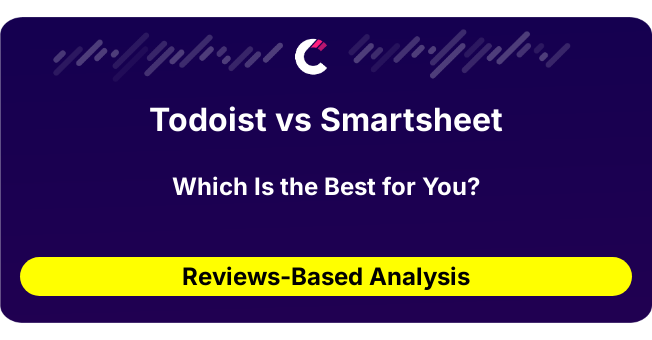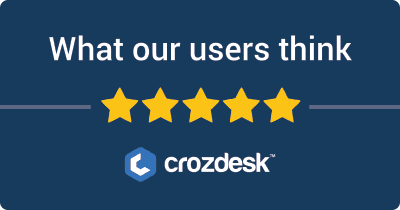
Comparing Todoist and Smartsheet: A Guide to Task Management Tools
Todoist and Smartsheet are two prominent tools in the realm of task management, each catering to different user needs. Todoist is designed primarily for individual users and small teams seeking a straightforward yet effective way to manage personal tasks and projects. Its focus is on enhancing productivity through to-do lists, reminders, and collaboration features. On the other hand, Smartsheet serves as a robust project management platform suitable for businesses and teams that require more extensive project tracking, resource allocation, and collaboration capabilities.
Users often consider these tools based on their specific requirements: Todoist is favored for its simplicity and ease of use, while Smartsheet appeals to those needing a more comprehensive project management solution.
Key Comparison Aspects:
- Features: Analyzing the range of functions and tools each platform provides.
- Pricing: Understanding the cost structures and value for money offered by both.
- Ease of Use: Evaluating how user-friendly each tool is for various levels of technical expertise.
- Integration: Considering the ability to connect with other software and apps for a streamlined workflow.
This comparison aims to provide clarity for users seeking the right task management tool that aligns with their individual or team needs.
Todoist VS Smartsheet: Which tool is the most popular?
| Tool | Number of Reviews | Average Rating | Positive Reviews | Neutral Reviews | Negative Reviews |
|---|---|---|---|---|---|
| Todoist | 13 | 3.46 | 7 | 2 | 4 |
| Smartsheet | 29 | 3.21 | 17 | 2 | 10 |
Todoist is more popular than Smartsheet in terms of user ratings, achieving a higher average rating of 3.46 compared to Smartsheet’s 3.21. However, Smartsheet has a greater number of reviews (29) compared to Todoist’s 13. Despite the higher volume of feedback for Smartsheet, Todoist maintains a more favorable average rating, indicating a stronger overall user satisfaction.


Todoist and Smartsheet: Quick Comparison Overview
| Feature/Aspect | Ahrefs | SEMrush |
|---|---|---|
| Primary Features | – Site Explorer – Keyword Explorer – Backlink Checker – Content Explorer – Rank Tracker |
– Keyword Research – Site Audit – Position Tracking – Content Analyzer – Marketing Insights |
| Target Audience | – SEO professionals – Digital marketers – Agencies focusing on content marketing and backlink analysis |
– Digital marketers – SEO experts – Content marketers – Social media marketers and PPC specialists |
| Main Advantages | – Robust backlink analysis – Comprehensive keyword data – Intuitive user interface – Constantly updated index |
– All-in-one digital marketing tool – Extensive competitor analysis – Wide array of tools for SEO and PPC – Integrated social media management |
| Core Value Proposition | Focused on providing in-depth SEO insights, particularly strengths in backlink profiles and organic keyword rankings. Ideal for users prioritizing content strategy and link-building efforts. | Offers a holistic view of digital marketing, making it easier to manage all aspects of online presence through an extensive range of tools for SEO, PPC, and social media marketing. |
| Ideal Use Cases | – Conducting comprehensive link audits – Developing effective content strategies – Tracking backlinks and organic rankings – Keyword planning for SEO campaigns |
– Managing and optimizing PPC campaigns – Conducting competitive analysis for market positioning – Comprehensive content analytics and SEO tracking – Social media metrics and management |
Most liked vs most disliked features of Todoist and Smartsheet
| Tool | Most Liked Features | Most Disliked Features |
|---|---|---|
| Todoist | – Efficient task entry with quick keystrokes | – Ongoing bugs, like SNOOZE reminder malfunctions |
| – User-friendly interface aiding navigation and organization | – Minor issues interrupting the flow | |
| – Customizable tasks, subtasks, and projects enhance engagement | – Customer service often unable to resolve ongoing bugs | |
| – Seamless synchronization and integrations with tools like Google Calendar and Slack | – Critical functions gated behind a paid subscription making it limited for free users | |
| – Responsive customer service for swift issue resolution | – Performance drawbacks compared to alternatives | |
| Smartsheet | – Facilitates collaboration with file sharing, notes, and task assignments | – Limitations of the free user profile leading to frustration |
| – User-friendly design for non-technical users | – More guidance needed for new users | |
| – Features for adding tasks, dependencies, and project tracking | – Desire for more intelligent integrations recommending best practices | |
| – Effective central project tracking | – Challenges integrating it into existing workflows and a learning curve for mastery | |
| – Cost-effective with good value for the features offered |
Key Features of Todoist vs Smartsheet
Sure! Here’s a comparison of the key features of Todoist and Smartsheet as task management tools, along with a description of how each feature benefits users and any unique aspects offered by each platform.
Todoist
1. Task Organization:
- Features: Todoist allows users to create tasks, sub-tasks, projects, and labels for organized management.
- Benefit: Users can easily structure and prioritize their tasks based on urgency or category, leading to improved productivity and focus.
- Unique Aspect: The option to create nested tasks (sub-tasks) helps in breaking down larger projects into manageable pieces.
2. Due Dates and Recurring Tasks:
- Features: Users can assign due dates and set tasks to recur at specified intervals.
- Benefit: This ensures that no task is forgotten and helps users effectively plan their schedules.
- Unique Aspect: The natural language processing feature allows users to type in dates in everyday language (e.g. “next Monday”), making it very user-friendly.
3. Collaboration Tools:
- Features: Users can share projects and collaborate with other team members by assigning tasks.
- Benefit: Enhances teamwork and ensures everyone’s responsibilities are clear.
- Unique Aspect: Allows real-time commenting on tasks, facilitating seamless communication within the app.
4. Prioritization:
- Features: Todoist lets users assign priority levels (Urgent, Medium, Low) to tasks.
- Benefit: Helps users focus on what’s most important and manage their time effectively.
- Unique Aspect: The gamification aspect, known as Karma, rewards users for completing tasks, which can enhance motivation.
5. Integration with Other Tools:
- Features: Todoist integrates with various applications like Google Calendar, Zapier, and more.
- Benefit: Increases flexibility and customization by allowing users to connect their task management with their existing workflows.
- Unique Aspect: The integration with tools like IFTTT enables users to automate tasks across different platforms.
Smartsheet
1. Grid, Card, and Gantt Views:
- Features: Smartsheet provides multiple views including grid, card, and Gantt charts.
- Benefit: Users can choose the view that best suits their project’s needs, whether they prefer a traditional spreadsheet or a visual representation.
- Unique Aspect: The Gantt chart feature offers a timeline visualization that is particularly useful for project planning and tracking.
2. Automated Workflows:
- Features: Users can create automated workflows to streamline repetitive tasks.
- Benefit: This saves time and reduces manual errors, allowing teams to focus on higher-level tasks.
- Unique Aspect: Custom automation rules can trigger alerts or notifications based on task updates or deadlines.
3. Resource Management:
- Features: Smartsheet includes tools for tracking resources and their allocations.
- Benefit: Assists users in managing team workloads and improving efficiency by ensuring resources are optimally utilized.
- Unique Aspect: The ability to see real-time availability and workload of team members can significantly enhance project management.
4. Collaboration and Sharing:
- Features: Smartsheet allows users to collaborate in real-time and share sheets with external users.
- Benefit: Enhances project transparency and ensures everyone has the latest information.
- Unique Aspect: The “Request an update” feature allows users to gather feedback and updates from collaborators easily.
5. Secure File Attachments and Comments:
- Features: Users can attach files and comment directly on rows or tasks within Smartsheet.
- Benefit: Keeps all necessary materials and communications in one place for easy access.
- Unique Aspect: The ability to attach files from cloud services (like Google Drive and Dropbox), as well as its own robust comment threads enhances collaboration.
Conclusion
Both Todoist and Smartsheet provide powerful task management tools suited to different user needs. Todoist excels in individual task organization and productivity optimization through its intuitive design and gamified elements. In contrast, Smartsheet shines in project management with its versatile views, automation capabilities, and resource tracking. Depending on whether users are looking for a straightforward personal to-do list tool or a comprehensive project management platform, either platform can be tailored to fit their specific requirements.
Todoist vs Smartsheet Pricing Comparison
| Pricing Tier | Todoist | Smartsheet |
|---|---|---|
| Free | $0/month | $0/month |
| Basic task management features | Limited features (basic Gantt chart, collaboration) | |
| Up to 5 active projects | Limited to 2 editors, basic templates | |
| 300 tasks per project | Limited reporting capabilities | |
| Pro | $4/month (billed annually) | $7/month (billed annually) |
| Advanced task management features | More robust project management tools | |
| 25 active projects | 10 dashboards; reporting features; resource management | |
| Comments & file attachments | Automated workflows | |
| Reminders & labels | ||
| Business | $6/month (billed annually) | $15/month (billed annually) |
| Team and collaboration features | Enhanced collaboration and sharing | |
| 300 active projects | 20 dashboards; customizable branding | |
| Priority support | Control over user access and permissions | |
| Integration with other apps | Advanced reporting and analytics | |
| Enterprise | $8/month (billed annually) | Custom Pricing |
| All Pro & Business features | Enterprise-level features tailored to large organizations | |
| Teams of over 250 users | Advanced security and compliance features | |
| Dedicated account manager | Custom onboarding and training | |
| Discounts | 20% discount for annual billing | Discounts available for annual subscriptions |
| Free trial for 14 days for Pro and Business | Free trial for 30 days |
Main Differences:
-
Focus and Features: Todoist emphasizes productivity and task management while Smartsheet focuses on project management with features like Gantt charts, dashboards, and resource management.
-
Pricing Structure: Todoist has a simpler pricing structure with lower costs at each tier, while Smartsheet offers more comprehensive project management tools but at a higher price point for similar tiers.
-
Collaboration: Smartsheet excels in collaboration tools for teams and organizations, offering advanced reporting and resource management compared to Todoist, which is primarily designed for individual task management with some collaboration features.
-
Free Options: Both platforms offer a free tier but with different limits on features, and duration for trials for paid plans varies.
-
Custom Enterprise Solutions: The enterprise tier for Smartsheet includes custom pricing and tailored features, while Todoist has a fixed rate with defined features.
Support Options Comparison: Todoist vs Smartsheet
| Support Option | Todoist | Smartsheet |
|---|---|---|
| Live Chat | Not available | Available during business hours |
| Phone Support | Not available | Available for higher-tier plans |
| Documentation | Comprehensive help center covering FAQs, guides, and community forum. | Extensive help center with articles, videos, and user guides. |
| Additional Resources | Offers a blog, podcasts, and user community for tips and collaboration. | Provides webinars, tutorials, and a resource library including templates. |
Unique Features of Todoist Vs Smartsheet
| Feature | Todoist | Smartsheet | Value Addition & Decision Factors |
|---|---|---|---|
| Karma System | Gamifies task completion by awarding points for completed tasks and streaks. | N/A | Encourages productivity through a gaming element, motivating users to maintain momentum and develop habits. |
| Project Templates | Allows users to create and use reusable templates for common projects. | Offers extensive pre-built templates for various scenarios. | Saves time and ensures consistency across repeated tasks or projects, making onboarding smoother. |
| Natural Language Processing | Users can input tasks in natural language, automatically creating due dates and reminders. | N/A | Simplifies task entry, allowing for quicker capture of ideas and action items without fussing over details. |
| Sub-tasks and Nested Tasks | Supports the organization of tasks into sub-tasks for clearer hierarchy. | Offers layers of interdependencies among tasks. | Facilitates detailed workflows, making it easier to manage large projects by breaking them down into manageable parts. |
| Collaboration Features | Enables users to assign tasks to team members and comment on tasks. | Advanced sharing and collaboration tools with real-time updates. | Todoist’s simple collaboration model helps small teams communicate effectively, while Smartsheet’s tools cater to larger team dynamics. |
| Sections and Labels | Organizes tasks into different sections and uses labels for categorization. | Has a more structured approach with customized fields and dropdowns. | Labels and sections in Todoist provide flexible organization, while Smartsheet’s structured data presentation aids detailed project tracking. |
| Recurring Tasks | Set tasks to repeat at customizable intervals. | Includes advanced automation workflows for task scheduling. | Todoist’s simplicity caters to users who need straightforward repetition, while Smartsheet’s automation appeals to complex projects needing refined scheduling. |
| Visual Progress Tracking | Displays task completion percentage through project progress. | Offers Gantt charts and dashboards for comprehensive project oversight. | Todoist’s tracking is visually straightforward, maintaining focus on individual tasks while Smartsheet’s tools provide a broader overview necessary for complex project management. |
| Integration with Email | Seamless integration with email to transform messages into tasks. | Advanced integration capabilities across various services and platforms. | Todoist offers a simplistic integration with email for basic task management, while Smartsheet’s extensive integrations facilitate complex workflows across different tools. |
| Focus Mode | A distraction-free interface to focus on current tasks without distractions. | N/A | Helps users concentrate on priority tasks in a clutter-free environment, enhancing productivity. |
Distinctive features of Todoist and Smartsheet, when compared to standard task management tools, showcase a mindful approach towards user experience, productivity, and collaboration. These features address various user needs, making them significant factors for potential users deciding on a task management solution.


